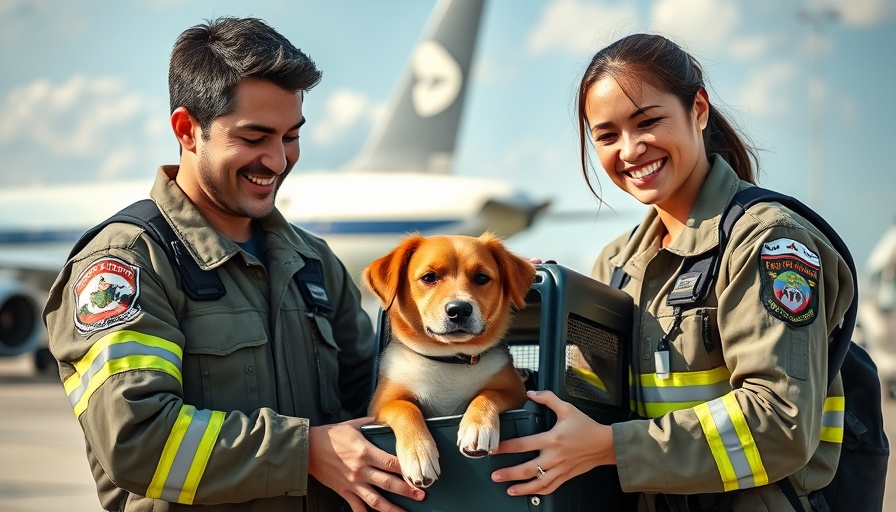
Understanding Anxious Behaviors in Dogs
As pet owners, we cherish the moments we share with our furry companions, but sometimes we face perplexing behaviors that challenge that bond. Anxiety-related actions like chewing and licking can puzzle even the most seasoned dog parents. Dr. Paola Cuevas brings clarity to these issues, helping us understand their origins and guiding us toward effective solutions.
Redirecting Obsessive Behaviors
In the case of Bonbin, a Corgie-Border Collie mix, the anxious licking is a sign of underlying stress or a call for attention. Dr. Paola advises that the first step is redirecting this behavior by offering her a task or incompatible action. Activities like placing her in a designated area or providing mental stimulation through food puzzles can make all the difference. Such strategies not only distract her but also fulfill her need for engagement, crucial for working breeds that thrive on having a job.
The Importance of Structured Activities
Structured mental and physical activities are fundamental in addressing anxiety for breeds like Bonbin. Engaging them in tasks such as obedience training sessions or scent games can satisfy their needs and redirect their focus. By integrating short training exercises or even creating a routine involving games like Treibball or “find it,” dogs can channel their energy positively, reducing the likelihood of compulsive behaviors.
Seeking Professional Guidance
If redirection strategies do not alleviate the obsessive licking, consulting a professional trainer or behaviorist can provide significant insights. Sometimes, merely adjusting a communication style or a daily routine can shift a pet’s negative behavior into a more manageable one. This collaborative approach can strengthen the relationship between pet and owner while ensuring the mental health of our companions.
The Science Behind Canine Anxiety
Understanding the science behind canine anxiety opens the door to more effective strategies. Dogs may exhibit compulsive licking due to factors such as a change in environment or uncertainty in their routine. Recent studies have shown that dogs with higher intelligence, like Bonbin, can develop anxiety if their mental stimulation needs are unmet. It's essential to recognize these patterns early, as timely intervention can prevent serious behavioral issues.
Why Every Dog Owner Should Be Informed
Every dog owner should be equipped with knowledge about their pet's health and behavior. Understanding anxiety and its symptoms allows pet parents to provide better support and care for their pets. Knowledge equates to power in pet ownership, moulding a secure environment for pets to thrive. Whether you are a veterinarian, trainer, or rescue organization, embracing this understanding enhances the overall well-being of dogs and their relationships with humans.
Practical Tips to Enhance Canine Well-being
Here are some practical tips for all pet professionals engaging with anxious dogs:
- Incorporate Variety: Ensure that physical and mental exercises are varied and challenging.
- Establish Routines: Build stable daily care routines that include ample time for both exercise and relaxation.
- Monitor Changes: Be vigilant about any sudden behavioral changes, as they could signify an emotional distress.
The Connection Between Mental and Physical Health
Maintaining a dog's mental health is just as crucial as their physical health. Engaging them in novel experiences helps combat loneliness and anxiety. For dog trainers and behaviorists, the knowledge of how vital relationships and stimulating activities are for a dog's emotional health is paramount in their practice. Those striving to support anxious dogs can implement techniques focused on creating a balance of both mental and physical pursuits.
Emphasizing the Importance of Community Support
Support from the community—be it from pet professionals or fellow pet parents—can make all the difference. Collaborating with veterinary teams or participating in community events often empower pet owners with accessible resources and shared experiences that bolster confidence in managing their pets' challenges.
In conclusion, anxiety in dogs, exemplified by behaviors like obsessive licking, can be a multifaceted challenge, but understanding how to redirect, engage, and inform can lead to significant improvements in health and happiness for our canine companions. Let’s continue to foster an informed community where pet lovers unite to support each other and their pets’ well-being.
Call to Action: Share Your Experience!
If you have dealt with similar concerns in your pet, we invite you to share your experiences or tips in the comments. Your insights may guide other pet parents navigating the complexities of canine anxiety!
 Add Row
Add Row  Add
Add 




Write A Comment